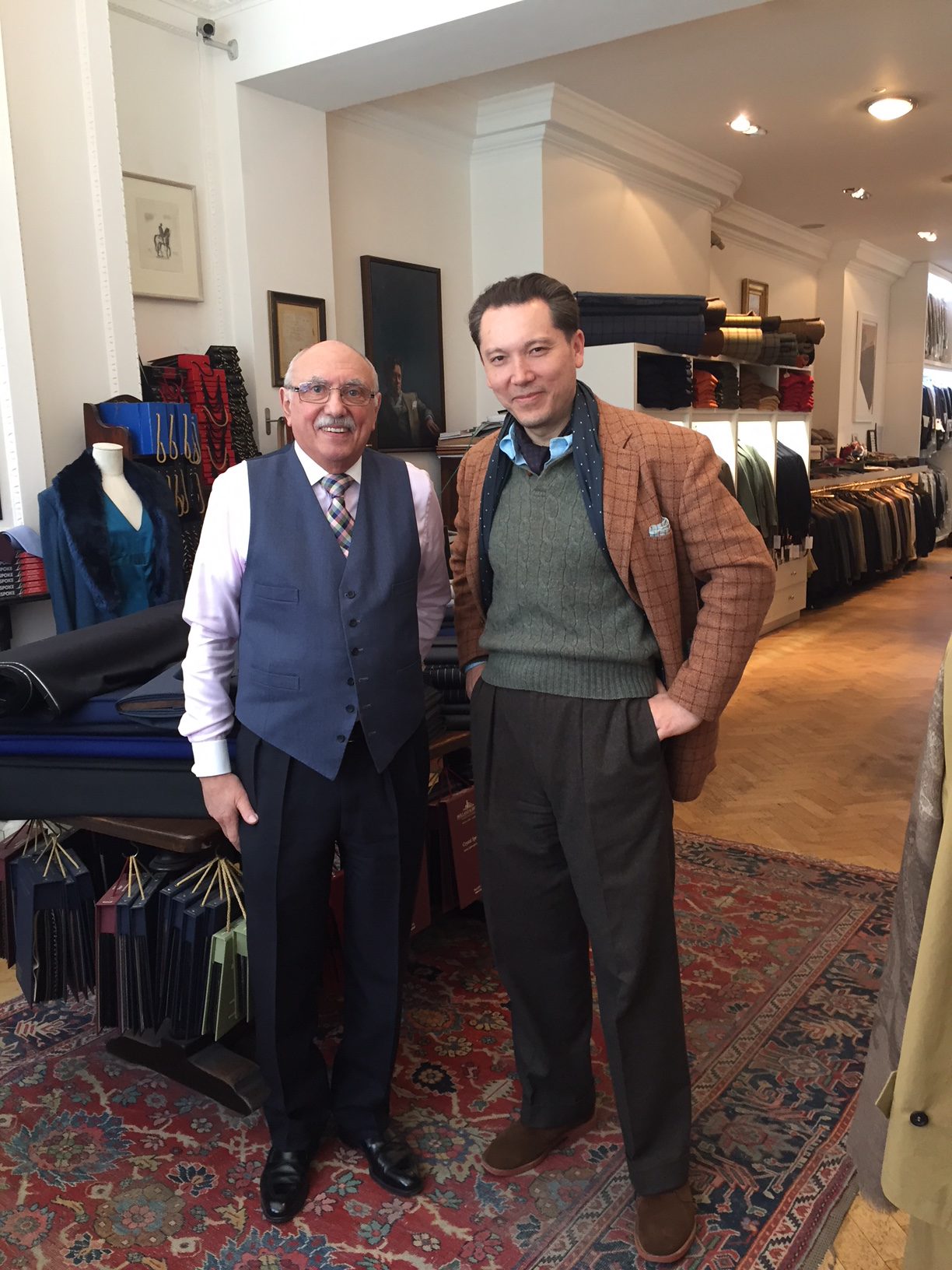The Personal Touch
It can take a lot of nerve to walk into a Savile Row shop, especially when you know you’re not going to be buying anything. I’d first found myself mustering this specific courage twenty years ago, as a college student, outfitted in my best secondhand suit and armed with what precious sartorial knowledge I’d been able to glean from the books of Alan Flusser and Bruce Boyer. On that day I’d made my rounds as swiftly and unobtrusively as possible, avoiding what I assumed would be censorious eye contact, purchasing a token pair of Thurston braces on my way out that I still have today — a stiffly-priced souvenir of my high-end reconnaissance.

This past spring, having put my wife and daughter on a tourist coach bound for Stonehenge, I found myself again on the Row, bright and early. A leisurely menswear-filled day stretched before me, but it had to begin where it had all begun — the short street where, two centuries earlier, Beau Brummell had ordered his sober clothing of perfect cut and proportion that forever changed how men dressed.
The first door I pushed on that morning was Richard Anderson’s. Not because I’m particularly enamored of his house style (a severely structured cut reflecting his training at Huntsman) but because his book Ripped and Smoothed — detailing his career from apprentice to master tailor and now proprietor of his own house — is the best insider’s account of the Row I’ve ever read. The most memorable character in Anderson’s book is actually Brian Lishak, a Savile Row man of the old breed, also formerly of Huntsman and now Anderson’s business partner. Lishak’s recollections of transatlantic liner crossings in the 1950s, travelling with a heap of steamer trunks filled with American commissions, evoke a lost world even by Savile Row standards. I couldn’t have been more excited to see him there at the front of the house, seated behind a small wooden desk which itself was hidden behind a table stacked high with bolts of the heavy British wool.
After a preemptive apology for (still!) not being in the market for a bespoke suit, I introduced myself as an employee of Alan Flusser’s. Lishak rocked on his heels and smiled as he recalled a young Alan popping into Huntsman in the 1970s. At that point Flusser was still getting his clothes made by a Roman tailor, and had only recently discovered a Savile Row, which — despite the best efforts of Tommy Nutter and Edward Sexton to keep it fresh and fashionable — had fallen on hard times. Alan would eventually go with Anderson & Sheppard for his own clothes, but the books he went on to write would soon help introduce a whole new generation of dressers to Savile Row more generally — a service Lishak recalled graciously.
I also explained that just earlier that week I’d been hired by the CTDA to write monthly articles by and for an audience of custom tailors and clothiers; Lishak approved with the relish of a man who, after six decades, still loves his work. He recalled his parents’ initial disapproval of their university-educated son pursuing a career on Savile Row at a time when tailoring was still considered a trade more fit for wounded veterans, whose amputated limbs were no liability given the tailor’s traditional cross-legged working position. Lishak found his niche working the front of house, selling a storied and eccentric clientele on the virtues of Huntsman’s sleek, quintessentially English, and famously expensive one-button house cut. “It’s a wonderful trade,” he reflected. “It’s got everything: luxury, tradition, craftsmanship, creativity, and characters.”
I couldn’t agree more, and it’s why I’m looking forward so much to the CTDA’s Designer Forum later this month in NYC. I had the good fortune to attend one years ago as a guest of Leonard Logsdail, and was struck by what a chummy, tight-knit circle it was; I learned that day that this trade is overwhelmingly composed of small businesses, run by people, for people. I was recently reminded of this when Kristine Trager announced her retirement. I had just recently come to know her as the friendly voice on the other end of the line when I’d call Isles Textiles for a price check on some cloth or other. Only after she’d come round our shop for an unexpected visit — one we’d later realize was a farewell — did I learn that she not only ran the entire company (which would close its doors on her departure), but that she’d also served as president for the CTDA itself. Somebody like that leaves a big hole in a small world like ours. Fortunately, I’m looking forward to dealing with James Sheed for our (formerly) Isles concerns; how can you not like someone who gives himself the title of “Cloth Enthusiast” on his business cards?
I’m still relatively new to this trade, but my ever-deepening impression is that it’s chock full of enthusiasts — people who love what they do, and who like to meet more of their tribe. This was why Brian Lishak was happy to spend fully two hours talking trade with someone he’d just met, and why, when he walked me to the back workroom, I found it filled with cheerful young tailors and apprentices. I envied the artisanal camaraderie they all clearly had, both in the shop and on the Row more generally; the American trade is far more diffuse, and even in New York City it lacks the geographic cohesion and common culture that make Savile Row and its environs such an international destination.
It’s precisely this diffusion, of course, that makes the CDTA such an important institution, and the Designer Forums such critical opportunities. Ours isn’t an industry of trade secrets; the state of our art is always going to be collectively, openly determined. What’s selling? What’s not? What distinguishes our individual members in the marketplace is generally less a matter of product than of taste and personality; getting to know those tastes and personalities is just good business. It’s also a good time. I look forward to meeting you all there!
By Andrew Yamato
